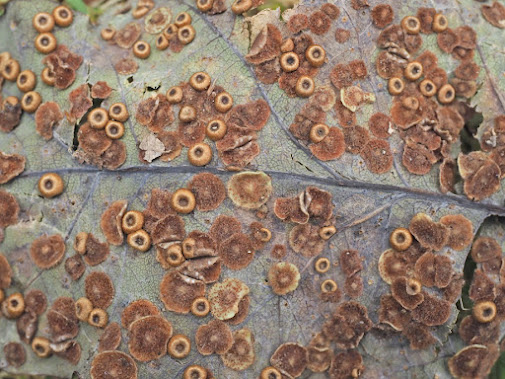We started from Longslade Bottom, went across the heath,
through Hinchelsea Wood, and back along the edge of Hinchelsea Bog, starting in
mist and low cloud, it soon lifted to leave light cloud.
A number of Swallows and House Martins were seen flying
over the lawns, many more gathered on the power lines.
 |
| Swallows and House Martins © Chris Robinson |
Not far along the path flowering Water-pepper was spotted growing
in the damp ditches. More wild flowers
were seen in the wet areas by the causeway, including seed heads of Marsh
Lousewort with a few still in flower.
Alongside these was a heavy cover of non-flowering Marsh St John’s-wort.
 |
| Marsh Lousewort © Sue Skarstein |
Heading up the track to the woods we had a good view of
Greenfinch, Chaffinch and Bullfinch feeding on a Rowan tree. At the top of the hill on the edge of the
woods, under the Scots pine there
were Holly trees recently coppiced by Commoners to provide young growth for the
ponies to eat this winter. Also in this area
Coal Tit and a Goldcrest were glimpsed flitting around the tops of the pines,
whilst lower down a Clouded Yellow butterfly flew past.
 |
An old pollarded Beech © Sue Skarstein
|
 |
| Artist's Bracket is usually found on Beech treees © Diane Potter |
|
In the woods there are many ancient pollarded Beech and Holly
trees and some very old Oak with
their leaves covered in asexual Common Spangle Neuropterus quercusbaccarum and female Silk Button Neuroterus
numismalis Galls. The recent rain had prompted some fungi to
start fruiting. Artist's Bracket Ganoderma applanatum is usually found growing on Beech.
 |
| Common Splangle and Silk-button Wasp galls © Diane Potter |
 |
| The galls in detail © Sue Skarstein |
On decaying Beech logs
there were many Small Stagshorn Calocera
cornea, Turkeytail Trametes
versicolor, Hairy Curtain Crust Stereum
hirsutum and Common Jellyspot Dacrymyces
stillatus. Further along the path in
a tall decaying tree stump boot lace like strands of Honey Fungus Armillaria known as rhizomorpha was
spotted. Then beside the stump, growing
on dead wood, a troop of Stump
Puffball Lycoperdon pyriforme, an
aged specimen of slime mould Fuligo septic and the nest of a
solitary wasp. The damper ground here being covered with
tree like Black Haircap moss (Polytrichastrum
formosum).
 |
| Stump Puffbals © Sue Skarstein |
 |
| Black Haircap - a moss © Sue Skarstein |
Bypassing a boggy area,
we came across two large fungi, thought to be Deer Shield Pluteus
cervinus, growing on a substantial
den and stockade built from fallen tree branches. Back on the path there
were more decaying fallen Beech where we found Southern Bracket Ganoderma
austral, masses of Beech Woodwort
Hypoxyln fragiforme, Beech Tarcrust Biscogniauxia nummularia and swarms of
Beech Jellydisc Neobulgaria pura.
 |
| Deer Shield © Sue Skarstein |
Leaving the
woods we crossed the bog where the path was lined with Bog Myrtle and walking back to Longslade along the edge of
the bog found the egg sac of a Wasp Spider Argiope bruennichi, also at this spot a couple of people saw a young Adder
curled up in the same gorse the sac was in.
It was an interesting sighting to end the walk. A&SS









